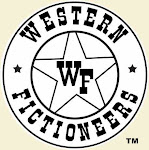Qualifications:
First time in print must be between January 1, 2015 and December 31, 2015, no reprints. Limit of 2 entries per category.
Books and short stories may be published in any country in the world (submissions must be in English) in print or electronic format. Electronic submissions must be made with Kindle/mobi , or Word/text files. WF reserves the right to decline any submission for consideration of an Award.
Authors, agents, or publishers may submit a work for consideration of an Award.
At least three entrants in the Best Western First Novel must be received during the submission period for an Award to be presented.
Novels and short stories must be set in the time period between 1830-1920 to be considered Westerns under WF guidelines. Time periods beyond the 1830-1920 traditional western focus may be included in submissions as long as the periods outside of the 1830-1920 span constitute no more than 50% of the story. At least 50% of the story MUST TAKE PLACE in the 1830-1920 period. NO EXCEPTIONS.
Nominees for the WF Peacemaker Award will be announced on 05/15/2016 and the winners will be announced on 06/015/2016.
The WF Peacemaker Award will be awarded in four categories:
Best Western Novel – Any novel published during the award year set in the appropriate time period (1830-1920), 30,000 words and higher. There are no format requirements. The novel may be a hardcover, trade paperback, mass market paperback, or eBook.
Best Western YA/Children Fiction– Any fiction written for ages 1-17 published during the award year set in the appropriate time period (1830-1920). May be a hardcover, trade paperback, mass market paperback, or eBook.
Best Western Short Fiction – Any short story, novelette, or novella published during the award year set in the appropriate time period (1830-1920), 500 words to 29,999 words. There are no format requirements. The short story may be published in any publication, print or electronic.
Best Western First Novel – Must meet the same requirements as Best Novel, and must be the author’s first published Western novel. If the author has published novels in any other genre they will not disqualify the author from the Best Western First Novel Award competition. Submissions for Best Western First Novel may also be submitted in the Best Novel category in the same year.
Judges and forms can be found on the Western Fictioneers website.
First time in print must be between January 1, 2015 and December 31, 2015, no reprints. Limit of 2 entries per category.
Books and short stories may be published in any country in the world (submissions must be in English) in print or electronic format. Electronic submissions must be made with Kindle/mobi , or Word/text files. WF reserves the right to decline any submission for consideration of an Award.
Authors, agents, or publishers may submit a work for consideration of an Award.
At least three entrants in the Best Western First Novel must be received during the submission period for an Award to be presented.
Novels and short stories must be set in the time period between 1830-1920 to be considered Westerns under WF guidelines. Time periods beyond the 1830-1920 traditional western focus may be included in submissions as long as the periods outside of the 1830-1920 span constitute no more than 50% of the story. At least 50% of the story MUST TAKE PLACE in the 1830-1920 period. NO EXCEPTIONS.
Nominees for the WF Peacemaker Award will be announced on 05/15/2016 and the winners will be announced on 06/015/2016.
The WF Peacemaker Award will be awarded in four categories:
Best Western Novel – Any novel published during the award year set in the appropriate time period (1830-1920), 30,000 words and higher. There are no format requirements. The novel may be a hardcover, trade paperback, mass market paperback, or eBook.
Best Western YA/Children Fiction– Any fiction written for ages 1-17 published during the award year set in the appropriate time period (1830-1920). May be a hardcover, trade paperback, mass market paperback, or eBook.
Best Western Short Fiction – Any short story, novelette, or novella published during the award year set in the appropriate time period (1830-1920), 500 words to 29,999 words. There are no format requirements. The short story may be published in any publication, print or electronic.
Best Western First Novel – Must meet the same requirements as Best Novel, and must be the author’s first published Western novel. If the author has published novels in any other genre they will not disqualify the author from the Best Western First Novel Award competition. Submissions for Best Western First Novel may also be submitted in the Best Novel category in the same year.
Judges and forms can be found on the Western Fictioneers website.





























